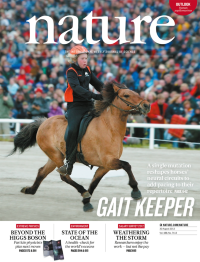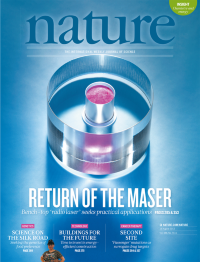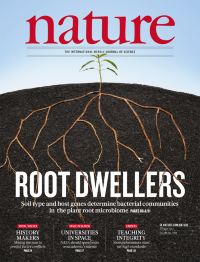Volume 488
-
No. 7413 30 August 2012
Some horses notably the harness-racing American Standardbred and the all-terrain Icelandic breed have the ability to perform extra gaits. All horses can walk, trot, canter and gallop, but some can also pace moving the two legs on the same side of the body in unison and/or perform other novel ambling gaits. A genome-wide association analysis of Icelandic horses has identified linkage between a premature stop codon in the DMRT3 gene and the ability to perform alternative gaits. Functional studies in mice show that Dmrt3 is expressed in a subset of spinal cord neurons that are crucial for the normal development of a coordinated locomotor network that controls limb movements. Dmrt3 may therefore have a key role in configuring the spinal circuits that control stride in vertebrates. In domestic horses, the DMRT3 mutation has had a major impact on the creatures diversification, because the altered gait characteristics of a number of breeds apparently require this mutation. Cover: A competitor in the Landsmót International Horse Competition for pure-bred Icelandic horses, Hella, Iceland, in 2004 (Arctic Images/Corbis).
Nature Outlook
-
No. 7412 23 August 2012
De novo mutations are important both as sources of diversity in evolution and for their immediate impact on diseases. Scientists at deCODE genetics and their colleagues have used whole-genome sequencing data from 78 Icelandic parentoffspring trios to study mutation rates in humans at the genome-wide level. They find that diversity in the mutation rate of single nucleotide polymorphisms is dominated by the age of the father at the time a child is conceived. For each year increase in the fathers age at conception, the number of mutations increases by about two, and once the effects of random variation are accounted for the fathers age is estimated to explain almost all of the remaining variation in the de novo mutation counts. Furthermore, the results show that demographic transitions that affect the age at which males reproduce can have a considerable effect on the rate of mutations, and consequently on the risk of diseases such as schizophrenia and autism. Cover image: Topic Photo Agency / Corbis.
-
No. 7411 16 August 2012
The maser is the microwave-frequency precursor of the now ubiquitous laser � or optical maser�, as it was once known. But it has had little technological impact compared with the laser, in large part because of inconvenience: masers typically require vacuum and/or low-temperature operating conditions. Overcoming these obstacles would pave the way for significant maser-based innovations, including drastically more sensitive measurements across a range of scientific disciplines, from molecular biology to radio astronomy. And, if the history of the laser is any indication, applications not yet dreamt of. Mark Oxborrow, Jonathan Breeze and Neil Alford have now developed a solid-state room-temperature maser, based on an organic molecular crystal, that should enhance the potential of the maser as a tool for science and technology. On the cover is their maser crystal inside its sapphire ring.
Insight
-
No. 7410 9 August 2012
Three hominin fossils newly discovered at Koobi Fora, east of Lake Turkana in Kenya, will greatly improve our understanding of the early radiation of the genus Homo, clarifying the iconic but enigmatic hominin cranium KNM-ER 1470, first described by Richard Leakey in Nature in 1973. The three are an exceptionally well-preserved lower jaw (KNM-ER 60000), a fragmentary lower jaw and, importantly, a well-preserved face. At between 1.78 million and 1.95 million years old, they broadly support the idea that there were at least two contemporary Homo species, in addition to Homo erectus, in the early Pleistocene of eastern Africa. The cover shows the KNM-ER 60000 lower jaw as a photographic reconstruction together with a digital visualization of KNM-ER 1470, which probably belongs to the same species. [Image by Fred Spoor]
-
No. 7409 2 August 2012
The association between a land plant and the soil microbes of the root microbiome is important for the plants well-being. A deeper understanding of these microbial communities will offer opportunities to control plant growth and susceptibility to pathogens, particularly in sustainable agricultural regimes. Two groups, working separately but developing best-practice protocols in parallel, have characterized the root microbiota of the model plant Arabidopis thaliana. Working on two continents and with five different soil types, they reach similar general conclusions. The bacterial communities in each root compartment — the rhizosphere immediately surrounding the root and the endophytic compartment within the root — are most strongly influenced by soil type, and to a lesser degree by host genotype. In natural soils, Arabidopsis plants are preferentially colonized by Actinobacteria, Proteobacteria, Bacteroidetes and Chloroflexi species. And — an important point for future work Arabidopsis root selectivity for soil bacteria under controlled environmental conditions mimics that of plants grown in a natural environment. Cover: Tim Robberts/Getty Images





